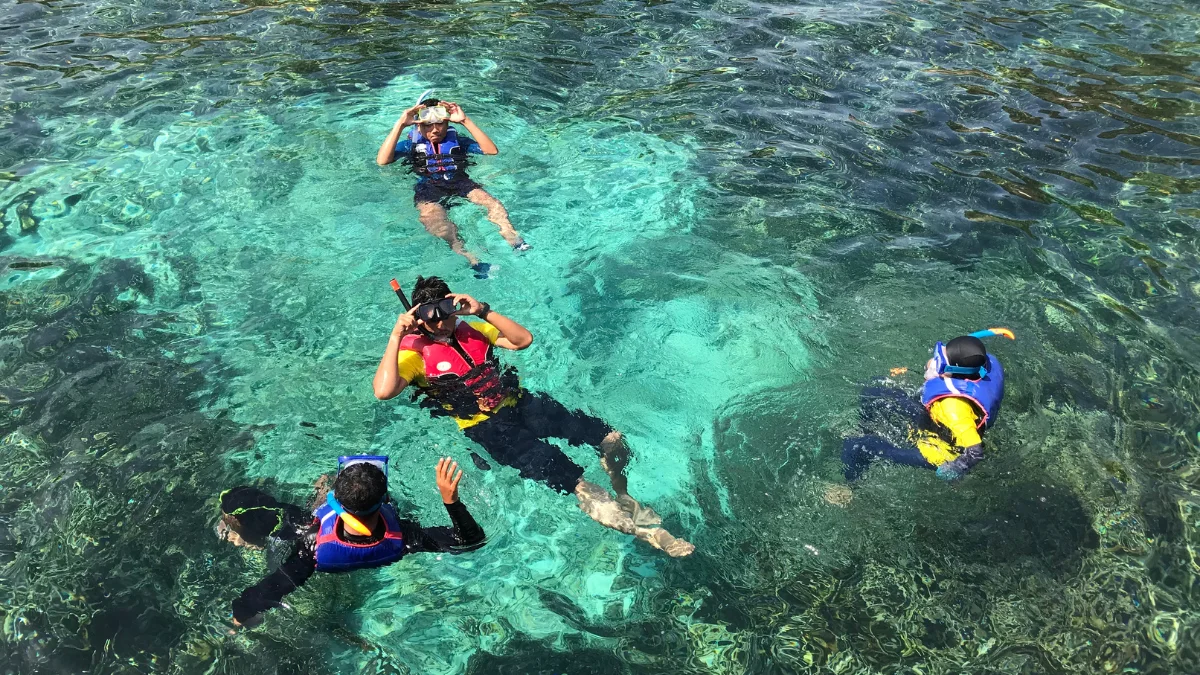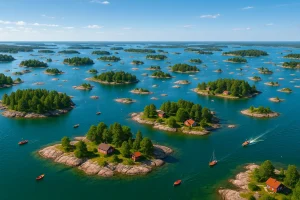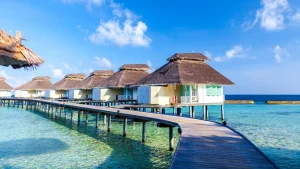There’s something about snorkeling in Maldives that just feels special. Warm water. Clear enough to see fish glide past your mask. You don’t even have to swim far. A lot of islands have reefs right next to the beach, so you just walk in, float, and watch the colors move under you. That’s why families, couples, even people traveling alone love it here. You don’t need to dive deep or have fancy gear.
A simple mask and fins do the trick. And it’s not just fish. You might see turtles, little reef sharks, maybe even a ray passing by. It’s calm too. No big waves most of the time. In this guide, you’ll see which spots are worth your time, what sea life shows up, what to pack so you don’t miss a thing, when the sea is at its best, how not to harm the reef, and quick answers people always ask. Maldives isn’t about rushing. You float, look down, and forget the world above for a bit. And that feeling, honestly, stays long after you’re back home. You can take our Maldives Honeymoon Packages or Maldives Tour Packages.
Top Snorkeling Spots in Maldives You Must Try
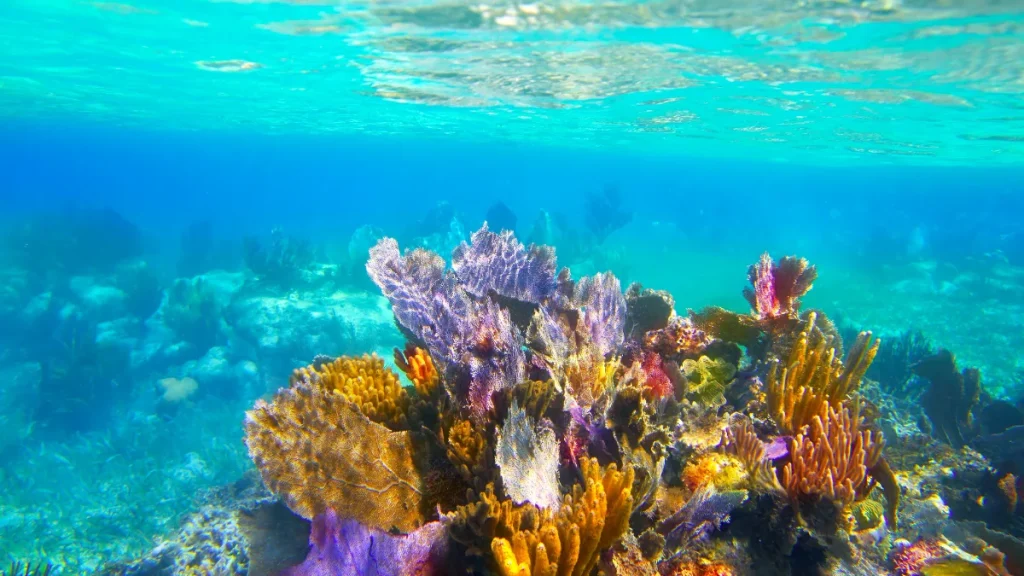
Not every reef feels the same. Some places stay calm, great for beginners. Some feel wild, with more fish than you can count. Here are a few snorkeling spots in Maldives that people keep picking as favorites in 2025.
Banana Reef (North Male Atoll) – This one’s famous. Shaped like a banana, the reef has caves and little overhangs where fish hide. You’ll see bannerfish, reef sharks, and sometimes big schools moving together. It’s easy to reach if you stay near Male.
HP Reef – Locals call it “High Point.” The soft coral here moves with the current and looks almost unreal when the sun hits right. You might spot tuna or a reef shark passing by. It’s better with a local guide who knows the safe parts.
Maaya Thila (Ari Atoll) – A small underwater pinnacle but full of life. People see turtles, white tip reef sharks, and lots of snapper and angelfish. Even snorkelers, not just divers, get close views here.
Hanifaru Bay (Baa Atoll) – Best known for manta rays gathering when there’s lots of plankton. It’s a protected spot, so you can’t touch or chase anything. Just float quietly and watch them glide by. Some people say it feels like flying underwater.
Resort House Reefs – Almost every resort in Maldives has its own reef. Some feel calm, great for first-timers. Others get busier fish traffic. The best part? You can snorkel anytime morning, sunset, or even night with a torch.
Here’s a simple table so you can see what makes each spot special:
| Spot | What You Might See |
| Banana Reef | Bannerfish, reef sharks, caves |
| HP Reef | Soft coral, tuna, reef sharks |
| Maaya Thila | Turtles, white tip sharks, snapper |
| Hanifaru Bay | Manta rays during plankton blooms |
| Resort House Reefs | Mixed reef fish, rays, coral |
Every reef brings something different. Some days you see a lot. Some days it’s quiet. But that’s what keeps it exciting.
Marine Life You’ll See While Snorkeling in Maldives
What really makes snorkeling in Maldives worth it? Sea life. You don’t need to dive deep or be an expert swimmer. Just float and watch. Even close to shore, you’ll see so much going on. Small reef fish are everywhere: parrotfish, butterflyfish, angelfish, all flashing colors when the sun hits right. It’s almost unreal. If you stop kicking and stay still, you’ll notice even more.
And turtles show up more than you’d think. Sometimes you see them pop up for air. Watching a turtle swim feels calm. Rays too. Eagle rays and stingrays sometimes glide by slowly, flapping like they’re flying under the sea.
It looks peaceful and kind of magical. Then you get reef sharks. Don’t panic, they’re usually small blacktip or whitetip ones, and they’re not really bothered by people. Most snorkelers feel lucky just to spot them. Sometimes they pass quickly, other times they circle at the edge of the reef.
The coral itself feels alive too. Hard coral sits like rocks, while soft coral moves gently with the water. On sunny days, everything glows brighter, almost like the reef is lit from inside.
Here’s a quick table of what you might see and where:
| What You Might See | Where & When |
| Parrotfish, butterflyfish | Shallow coral, most times |
| Sea turtles | Morning, late afternoon |
| Reef sharks | Edge of reef, early morning |
| Rays | Sandy parts, midday sometimes |
| Soft and hard coral | All day, best when sunny |
It’s never the same twice. Some days feel busy underwater, some calm but even a quiet day feels special.
Packing List for Snorkeling in Maldives
You really don’t need much to enjoy snorkeling in Maldives, but forgetting even small stuff can spoil a day. Here’s what most people bring (and why). No fancy gear, just basics that help you stay comfy and safe.
Mask and snorkel that fit you well – Resorts lend them, but rented ones sometimes leak or fog more. If you’ve got space, bring your own.
Fins – Short fins work fine for reef spots. They help you move without getting tired and keep you from kicking coral by accident.
Rash guard or swim shirt – The sun hits strongly here, even if it feels cloudy. Better than sunscreen alone and protects your back and shoulders.
Reef-safe sunscreen – Regular ones harm coral. Pick one that says “reef safe,” and reapply after swimming.
Underwater camera or GoPro – Not needed, but it’s fun to look back at what you saw. Even phone cases that seal tight can work for shallow water.
Small dry bag – Keeps your phone, key, or money safe from splashes on boats or the beach.
Towel or quick-dry cloth – Obvious, but easy to forget if you pack in a hurry.
Water shoes (optional) – Some beaches have coral rubble or sharp shells near shore.
Here’s a quick table so it’s easy to check off:
| Item | Why It Helps |
| Mask & snorkel | Clear view, fits your face better |
| Fins | Swim easier, protect coral |
| Rash guard | Sun safety without sticky sunscreen |
| Reef-safe sunscreen | Protects coral and your skin |
| Waterproof camera | Keep memories |
| Dry bag | Keep phone, cash dry |
| Quick-dry towel | Small, dries fast |
| Water shoes | Walk over shells safely |
Best Time to Go Snorkeling in Maldives
Truth is, you can snorkel in Maldives pretty much anytime. The water stays warm all year. But yeah, some months feel nicer. Most people say November to April is best. Dry season. The sea feels calmer, skies clear, and the sun bright. The water looks blue and clean. You float and see coral like glass. It’s busy then though with more people, higher prices, but reefs look amazing.
Then there’s May to October. Wet season. You get rain showers, clouds, and wind picks up sometimes. Water can turn a bit murky. But fewer tourists, so spots feel empty. Prices drop at some resorts too. Some days it rains hard, then the sun pops back out. Locals say the weather can change quickly.
The funny thing is, some big stuff shows up in the wet season. Like manta rays and whale sharks. They come to feed on plankton. Especially in places like Hanifaru Bay. So even if the sea isn’t crystal clear, you might see something huge glide right past. Water temp? Warm. Feels like bath water most days. Rarely need a wetsuit, maybe just a rash guard so you don’t burn.
Here’s it simple:
| Season | Months | What it feels like |
| Dry | Nov–Apr | Calm sea, sun, clear water |
| Wet | May–Oct | More rain, wind, big sea life |
No real bad time. Just a different feeling. Ask locals each morning. Some days currents get strong. Better safe than sorry.
Responsible Snorkeling: Protecting Maldives’ Marine Beauty
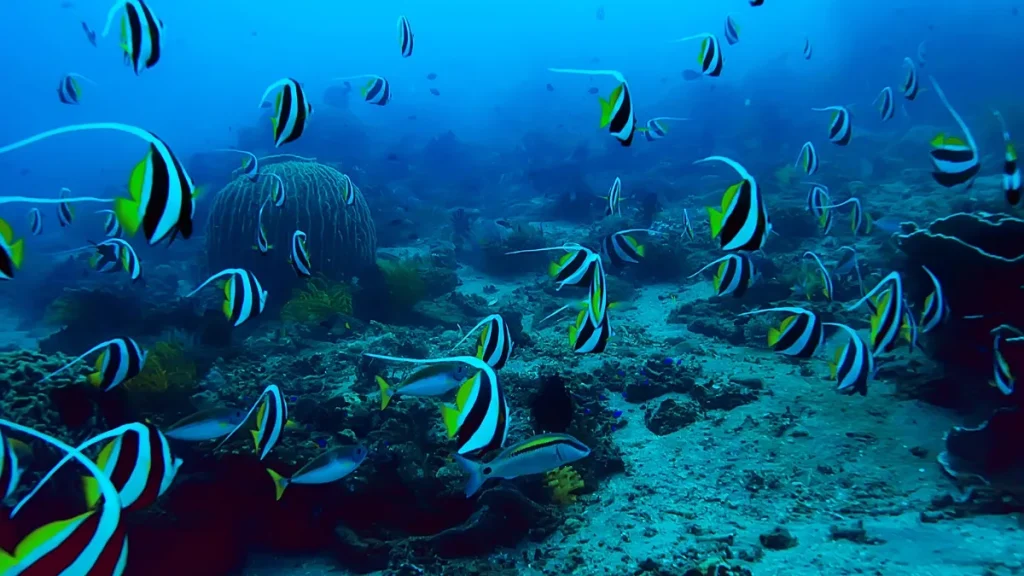
- Snorkeling in Maldives isn’t just about seeing fish and coral. It’s about keeping them safe too. Reefs here look amazing, but they’re fragile. Tiny things hurt them like kicking, touching, or even sunscreen.
- First thing? Don’t touch coral. Even a light bump breaks tiny parts and takes years to grow back. Feels harmless, but it isn’t. Same goes for shells, starfish, or anything you see. Look, don’t touch.
- Don’t stand on coral. Some spots feel shallow. Just float. Standing crushes living coral under your feet. Use fins to stay above, slow kicks, gentle moves.
- Pick reef-safe sunscreen. Many normal sunscreens have stuff that hurts coral. Check the label. Better yet, wear a rash guard so you use less.
- No feeding fish. Resorts say it, but people forget. It changes how fish act and can mess up the reef’s balance.
- Don’t chase turtles or rays. Let them swim. You’ll see more if you stay calm. Fast moves scare them, and they might leave.
- Take trash back. Even small bits. Plastic blows off boats and beaches and stays in the sea for years.
Here’s a quick table to remember:
| Do | Don’t |
| Float calmly | Touch or stand on coral |
| Use reef-safe sunscreen | Feed fish |
| Wear rash guard | Chase turtles or rays |
| Take trash back | Break or collect shells |
Feels small, but it matters. Reefs in Maldives get millions of visitors. One person being careful helps more than you think.
Conclusion
Snorkeling in Maldives isn’t about being an expert. It’s about slowing down, floating on warm water, and just watching life happen under you. Clear seas, bright coral, turtles gliding by it feels unreal at first. But it sticks in your mind long after you leave.
You don’t need fancy gear. Just a good mask, some fins, and a bit of care for the reef. The sea here does the rest. House reefs right by the shore make it easy even if it’s your first time. Some days you might see a reef shark. Other days, maybe just small fish and coral. But every swim feels different.
Best months? Usually November to April if you want calm water and sun. But the wet season has its own magic too, like manta rays and fewer crowds. There isn’t really a “bad” time. Just pick what feels right for you.
Biggest thing? Go gentle. Float, look, and leave nothing behind. The reefs here stay beautiful only if people treat them gently.
And don’t forget why you came. It’s not just fish or photos. It’s that quiet moment, face down in clear water, forgetting your phone and the world above. That’s what really stays with you. You can take our Maldives Honeymoon Packages or Maldives Tour Packages.
FAQ – People Also Ask
Q.1 Is snorkeling in Maldives safe for beginners?
Yeah, pretty safe. The water’s warm, reefs sit close to the beach. Just wear a vest if you can’t swim well. Go slow, don’t panic. Most people do fine.
Q.2 Do I need to know how to swim?
Helps, but not a must. You can float with a vest or noodle. Stay near shallow parts. Don’t go alone.
Q.3 Best time of year?
Most say Nov to April. The sea’s calm, the sun’s out, and the water’s clear. May to Oct has more rain but you might see manta rays. Depends what you want.
Q.4 Will I see sharks?
Maybe. Small reef sharks. Blacktip or whitetip. They don’t bother people. Feels more cool than scary.
Q.5 Should I bring my own mask?
Good idea. Resorts have gear but sometimes it leaks. A mask that fits your face makes it better.
Q.6 What fish can I see?
All sorts. Parrotfish, butterflyfish, turtles, rays, little sharks. And coral that looks alive when water’s still.
Q.7 Are there strong currents?
Sometimes. Best ask local staff each day. Most house reefs stay calm.
Q.8 Is sunscreen bad?
Yeah, normal ones are. Get reef-safe sunscreen. Or better, wear a rash guard so you use less.
Q.9 Can kids do it?
Sure. Lots of families snorkel. Keep them in shallow water, put them in vests, and stay close.

